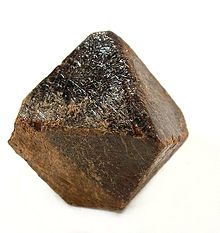
Back بيروكلور Arabic Piroxlor Azerbaijani Grup del piroclor Catalan Pyrochlor German Πυρόχλωρο Greek Pirocloro Spanish پیروکلر Persian Pyrochlore French Պիրոքլոր Armenian Pirocloro Italian
| Pyrochlore | |
|---|---|
 Pyrochlore from Russia | |
| General | |
| Category | Oxide mineral |
| Formula (repeating unit) | (Na,Ca)2Nb2O6(OH,F) |
| IMA symbol | Pcl[1] |
| Strunz classification | 4.DH.15 |
| Dana classification | 08.02.01.01 Pyrochlore group |
| Crystal system | Isometric |
| Crystal class | Hexoctahedral (m3m) H-M symbol: (4/m 3 2/m) |
| Space group | Fd3m (No. 227) |
| Unit cell | a = 10.41(6) Å, Z = 8 |
| Identification | |
| Color | Black to brown, chocolate-brown, reddish brown, amber-orange, red-orange |
| Crystal habit | Typically octahedra, disseminated granular, massive |
| Twinning | 111 rare |
| Cleavage | 111 indistinct, may be a parting. |
| Fracture | Subconchoidal to uneven, splintery |
| Tenacity | Brittle |
| Mohs scale hardness | 5.0–5.5 |
| Luster | Vitreous to resinous |
| Streak | White |
| Diaphaneity | Subtranslucent to opaque |
| Specific gravity | 4.45 to 4.90 |
| Optical properties | Isotropic, weak anomalous anisotropism |
| Refractive index | n = 1.9–2.2 |
| Other characteristics | |
| References | [2][3][4][5] |
Pyrochlore (Na,Ca)2Nb2O6(OH,F) is a mineral group of the niobium end member of the pyrochlore supergroup. Pyrochlore is also a term for the crystal structure Fd3m. The name is from the Greek πῦρ, fire, and χλωρός, green because it typically turns green on ignition in classic blowpipe analysis.[4]
- ^ Warr, L.N. (2021). "IMA–CNMNC approved mineral symbols". Mineralogical Magazine. 85 (3): 291–320. Bibcode:2021MinM...85..291W. doi:10.1180/mgm.2021.43. S2CID 235729616.
- ^ "Pyrochlor". www.mineralienatlas.de.
- ^ "pyrochlore at RRuff database" (PDF). rruff.info. Retrieved 2015-02-03.
- ^ a b "Pyrochlore Group: Pyrochlore Group mineral information and data". mindat.org. Retrieved 2015-02-03.
- ^ Barthelmy, Dave. "Pyrochlore Mineral Data". webmineral.com. Retrieved 2015-02-03.